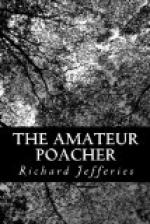Near the stream the ground is perhaps peaty: little black pools appear between tufts of grass, some of them streaked with a reddish or yellowish slime that glistens on the surface of the dark water; and as you step there is a hissing sound as the spongy earth yields, and a tiny spout is forced forth several yards distant. Some of the drier part of the soil the moucher takes to sell for use in gardens and flower-pots as peat.
The years roll on, and he grows old. But no feebleness of body or mind can induce him to enter the workhouse; he cannot quit his old haunts. Let it rain or sleet, or let the furious gale drive broken boughs across the road, he still sleeps in some shed or under a straw-rick. In sheer pity he is committed every now and then to prison for vagabondage—not for punishment, but in order to save him from himself. It is in vain: the moment he is out he returns to his habits. All he wants is a little beer—he is not a drunkard—and a little tobacco, and the hedges. Some chilly evening, as the shadows thicken, he shambles out of the town, and seeks the limekiln in the ploughed field, where, the substratum being limestone, the farmer burns it. Near the top of the kiln the ground is warm; there he reclines and sleeps.
The night goes on. Out from the broken blocks of stone now and again there rises a lambent flame, to shine like a meteor for a moment and then disappear. The rain falls. The moucher moves uneasily in his sleep; instinctively he rolls or crawls towards the warmth, and presently lies extended on the top of the kiln. The wings of the water-fowl hurtle in the air as they go over; by-and-by the heron utters his loud call.
Very early in the morning the quarryman comes to tend his fire, and starts to see on the now redhot and glowing stones, sunk below the rim, the presentment of a skeleton formed of the purest white ashes—a ghastly spectacle in the grey of the dawn, as the mist rises and the peewit plaintively whistles over the marshy meadow.
CHAPTER VIII
CHURCHYARD PHEASANTS: BEFORE THE BENCH
The tower of the church at Essant Hill was so low that it scarcely seemed to rise above the maples in the hedges. It could not be seen until the last stile in the footpath across the meadows was passed. Church and tower then came into view together on the opposite side of a large open field. A few aged hawthorn trees dotted the sward, and beyond the church the outskirts of a wood were visible, but no dwellings could be seen. Upon a second and more careful glance, however, the chimney of a cottage appeared above a hedge, so covered with ivy as hardly to be separated from the green of the boughs.




